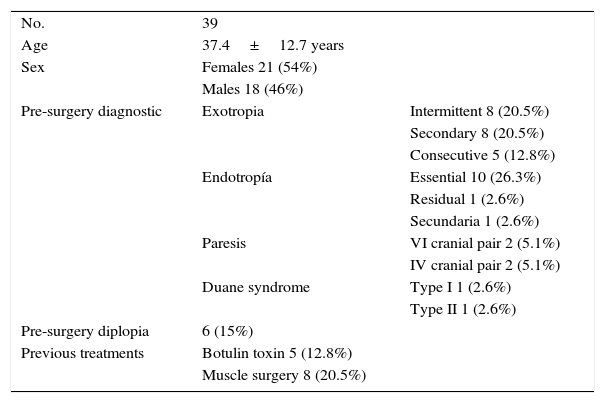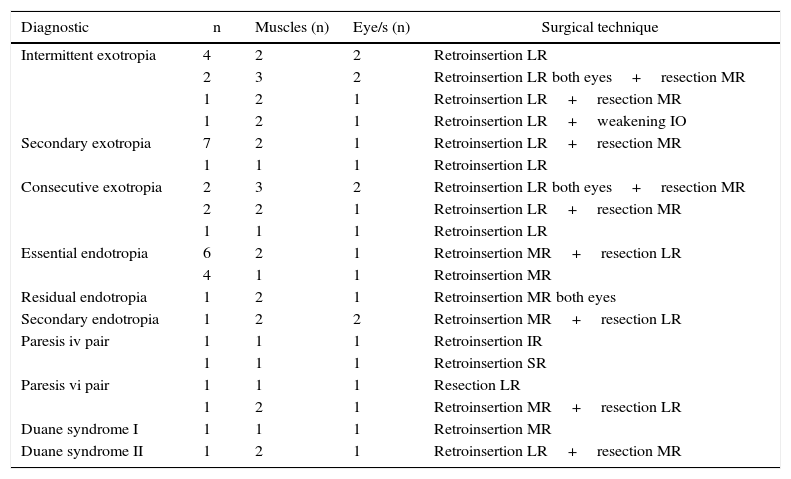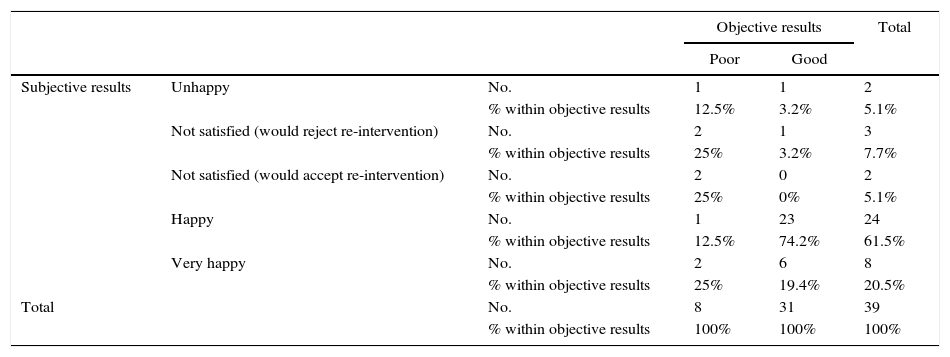To analyze the analgesic effect of remifentanil, side effects and complications in topical strabismus surgery. To study the results of strabismus surgery with this type of anesthesia.
Material and methodRetrospective descriptive study. We included 39 patients undergoing strabismus surgery with topical anesthesia and analgesia-based sedation with remifentanil. The data of the anesthetic and surgical technique, surgical results and stability of the deviation angle were analyzed.
ResultsThirty-nine patients (54% women) were included, the average age was 37.4 years old. The mean follow-up was 24.5 months. The preoperative diagnoses were exotropia (21 patients), esotropia (12), paresis strabismus (4) and Duane's Syndrome (2). 15% patients had preoperative diplopia and 13 had received previous treatments. The dose range of remifentanil used was 0.05–0.2μg/kg/min. The side effects presented were 2 cases of vomit and one of bad collaboration during the intraoperative adjustment, one of the patient reported pain and one case of thoracic rigidity was reported. 79% of the patients obtained a good surgical result and 82% reported being satisfied with the results. The reintervention rate was 5%.
ConclusionsAnalgesia-based sedation with remifentanil is an useful complement to topical strabismus surgery because it reduces pain during surgery and allows the patient to collaborate during intraoperative adjustment due to its pharmacokinetic characteristics.
Analizar el efecto analgésico del remifentanilo, sus efectos secundarios y las complicaciones en la cirugía tópica del estrabismo. Estudiar los resultados de la cirugía del estrabismo con este tipo de anestesia.
Material y métodoEstudio descriptivo retrospectivo. Se incluyeron 39 pacientes intervenidos de cirugía de estrabismo con anestesia tópica y analgesia basada en sedación con remifentanilo. Se analizaron los datos sobre las técnicas anestésica y quirúrgica, los resultados quirúrgicos y la estabilidad del ángulo de desviación.
ResultadosSe incluyeron 39 pacientes (54% mujeres), con una edad media de 37,4 años. El tiempo medio de seguimiento fue de 24,5 meses. Los diagnósticos preoperatorios fueron exotropía (21 pacientes), endotropía (12), estrabismos paréticos (4) y estrabismo restrictivo por síndrome de Duane (2). El 15% de los pacientes presentaban diplopía prequirúrgica y 13 habían recibido tratamientos previos. El rango de dosis de remifentanilo utilizado fue de 0,05 a 0,2 μg/kg/min. Los efectos secundarios que se presentaron fueron 2 casos de vómitos y uno de mala colaboración durante el ajuste intraoperatorio, un paciente refirió dolor franco y se reportó un caso de rigidez torácica. El 79% de los pacientes obtuvieron buen resultado quirúrgico y el 82% refirieron estar contentos con los resultados. La tasa de reintervención fue del 5%.
ConclusionesLa analgesia basada en la sedación con remifentanilo puede resultar un complemento útil en la cirugía tópica del estrabismo, ya que disminuye el dolor durante la cirugía permitiendo que el paciente colabore durante el ajuste intraoperatorio gracias a sus características farmacocinéticas.









